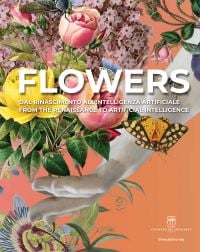
Flowers Forever – Cloister of Bramante, Italy
14 Feb — 14 Sep 2025
Flowers in art, from the Renaissance to the virtual
Curated by Franziska Stöhr in collaboration with Suzanne Landau
From February 14th to September 14th 2025
“FLOWERS”: THE BRAMANTE CLOISTER CELEBRATES FLOWERS IN ART WITH THE LARGEST ITALIAN EXHIBITION DEDICATED TO THEIR BEAUTY AND STRENGTH
From February 14 to September 14, 2025, “Flowers. Flowers in art, from the Renaissance to the virtual” presents a journey through the inexhaustible evocative power of flowers, capable of uniting art, science, and technology in a universal story that spans the centuries: from the masterpieces of Jan Brueghel and Ai Weiwei to the most recent experiments in contemporary art with digital technologies.
Fragile and powerful, flowers speak a universal language capable of crossing centuries and cultures.
They tell emotions, celebrate beauty, protest silently and guard ancient stories. And it is precisely to them that the Chiostro del Bramante in Rome dedicates an extraordinary exhibition: “Flowers. Flowers in art, from the Renaissance to the virtual”, scheduled from 14 February to 14 September 2025. Curated by Franziska Stöhr in collaboration with Suzanne Landau, the exhibition offers a journey through five centuries of art, culture and innovation.
“Flowers are much more than simple decorative elements,” explains Natalia de Marco, Artistic Director of the Chiostro del Bramante. “They are universal symbols that represent every aspect of life: from resistance to spirituality, from love to conflict, from science to ecology. ” This sensory journey comes to life in an exhibition that unites works from the past and the present, offering the public a new reading of the role that flowers have had in the evolution of our history and our society.
The works of art on display range from the 16th to the 21st century. Paintings, sculptures, manuscripts, tapestries, photographs, site-specific installations and augmented reality works intertwine to tell the story of the encounter between art and nature. Among the Masters present, Jan Brueghel the Elder and his narration of flowers as silent protagonists of a broad symbolic universe, between the sacred and the profane; Girolamo Pini and his extraordinary attention to botanical detail; Edward Burne-Jones and William Morris and their delicate floral representations, which evoke a sense of ethereal beauty typical of the Pre-Raphaelite movement.
Alongside these historical works, we find contemporary installations by Ai Weiwei, which use flowers as a metaphor for resistance and regeneration, emphasizing the social and environmental challenges of our time. A strong point of the exhibition is, moreover, the use of new technologies. Among the contemporary artists present, Studio Drift fascinates with its technological installations inspired by natural processes, while Kehinde Wiley offers a bold and vibrant interpretation of the floral theme. Miguel Chevalier explores the digital language with immersive works, and Rebecca Louise Law creates an evocative corridor in which the public will be literally submerged by flowers, offering a sensory experience at least as unique as the olfactory path hosted in another area of the exhibition space. The exterior of the Chiostro del Bramante will also be the protagonist, completely transformed into a true earthly paradise by an installation by Austin Young / Fallen Fruit.
A special section is dedicated to flowers in science and politics, underlining how these natural symbols have often played a crucial role in cultural and social dynamics, from ecological issues (perfectly exemplified by the various references to the “artistic” dimension of bees, thanks to their tireless work of pollination) to battles for civil rights.
The over 90 works of art on display come from 10 different countries around the world : the Chiostro del Bramante has involved prestigious institutions such as the Louvre, the Musée d’Orsay, the Petit Palais and the Musée des Arts Décoratifs in Paris, alongside the botanical and scientific collections of the Kew Gardens in London and the Museo Civico di Zoologia in Rome. The lenders also include the Galleria Borghese, the Biblioteca Casanatense, the Badisches Landesmuseum in Karlsruhe and the Israel Museum in Jerusalem.
Produced in collaboration with the Kunsthalle München, the exhibition demonstrates how flowers are an inexhaustible source of inspiration for artists of all ages. “The beauty of flowers is universal, but their interpretation changes over time and space,” observes Natalia de Marco. “This exhibition is an invitation to rediscover the evocative power of these extraordinary gifts of nature.”
The Chiostro del Bramante, a place of exceptional sixteenth-century charm, offers the ideal setting for an event that combines art, nature and technology. “ Flowers. Flowers in art, from the Renaissance to the virtual ” promises to be one of the most evocative exhibitions of 2025, a journey through beauty and strength that will excite and surprise the public.
Please log-in or create an account to see your recent items.